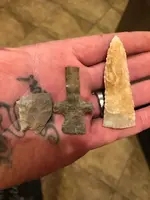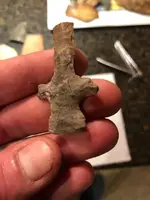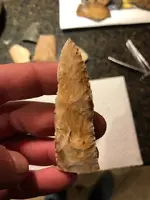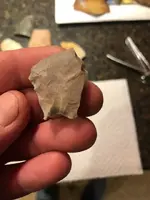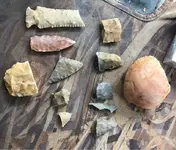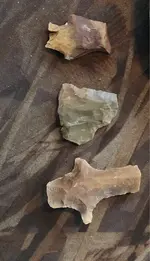You are using an out of date browser. It may not display this or other websites correctly.
You should upgrade or use an alternative browser.
You should upgrade or use an alternative browser.
Heartbreaker drill pf today
- Thread starter Dirttrax
- Start date
MAMucker
Bronze Member
- Joined
- Feb 2, 2019
- Messages
- 1,636
- Reaction score
- 2,980
- Golden Thread
- 0
- Location
- Massachusetts
- Primary Interest:
- Other
Interesting items. It’s difficult to identify a type from a broken tip, but you may get a good guess from someone in your area. That drill has a very distinct base and should represent a specific point type (Lobed Base). The location where you found it is critical though.
Nice perforator/scriber.
I’m guessing Archaic for all.
Nice perforator/scriber.
I’m guessing Archaic for all.
arrow86
Silver Member
- Joined
- May 6, 2014
- Messages
- 3,374
- Reaction score
- 4,077
- Golden Thread
- 0
- Location
- Eastern Shore Maryland
- Primary Interest:
- All Treasure Hunting
Heartbreakers for sure
dognose
Silver Member
Nice relics.
check the brake area of the drill. Is it clean or are there mineralization on it? Does is appear to have sharp edges or is it work dull?
A clean sharp break may indicate relatively recent breakage, which would then increase the possibility of finding the tip portion of the drill somewhere in the vicinity.
If mineralization in the broke area and somewhat dull, it could have been in the ground broke for a long, long time. This reduces the odds of finding the rest.
By somewhere in the vicinity, it could be anywhere from a foot away to possibly 20 to 40 feet depending on the number of years broke and the depth/quantity of tillage and lay of the land. Was it on a rise which would maybe increase its ability to move downhill with heavy rain - that sort of thing.
Most bean or corn are turned over once to 2/3 times a calendar year. Spring and fall. I once hunted a beet field with amazing luck, since the farmer got three or four harvest a year, which meant he turned over the ground that many times. That was in the 80's and there are houses there now unfortunately.
This is a blade part I found yesterday, and is in the post Central Indiana Finds today. Note the arrows showing mineralization in the break area. I spaced adding the photo, so I will also add it there.
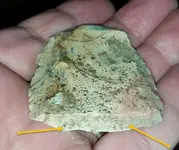
check the brake area of the drill. Is it clean or are there mineralization on it? Does is appear to have sharp edges or is it work dull?
A clean sharp break may indicate relatively recent breakage, which would then increase the possibility of finding the tip portion of the drill somewhere in the vicinity.
If mineralization in the broke area and somewhat dull, it could have been in the ground broke for a long, long time. This reduces the odds of finding the rest.
By somewhere in the vicinity, it could be anywhere from a foot away to possibly 20 to 40 feet depending on the number of years broke and the depth/quantity of tillage and lay of the land. Was it on a rise which would maybe increase its ability to move downhill with heavy rain - that sort of thing.
Most bean or corn are turned over once to 2/3 times a calendar year. Spring and fall. I once hunted a beet field with amazing luck, since the farmer got three or four harvest a year, which meant he turned over the ground that many times. That was in the 80's and there are houses there now unfortunately.
This is a blade part I found yesterday, and is in the post Central Indiana Finds today. Note the arrows showing mineralization in the break area. I spaced adding the photo, so I will also add it there.

Similar threads
- Replies
- 10
- Views
- 430
- Replies
- 5
- Views
- 427
Users who are viewing this thread
Total: 1 (members: 0, guests: 1)
Latest Discussions
-
-
-
-
Naturallly Occuring Formation OR Manmade Treasure Marker/Sign?
- Latest: Crosse De Sign
-
-

